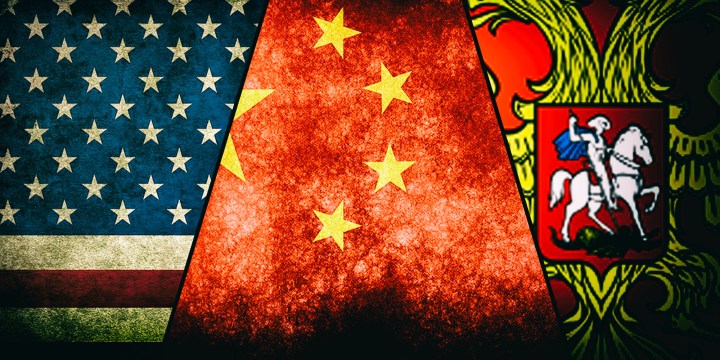SUPERPOWER SHOWDOWN
A new world order emerges as Trump once again ignores history

Donald Trump’s tariff threats as the key — and maybe only — element of his foreign policy tactics and strategy have now helped unravel a very real diplomatic achievement of a flawed Richard Nixon and his Secretary of State, Henry Kissinger. A great power equilibrium between the US, Russia, and China that lasted for decades is now coming unstuck and a new order is coming into view.
Donald Trump versus Richard Nixon. For many readers, the comparison almost writes itself, what with all those official scandals, personal improprieties, self-incriminating public statements and their respective sleazy coteries of mendacious aides and amoral enablers.
But there is one enormous difference. And that, of course, is in foreign affairs. For Nixon, if we can manage to excuse his deep dishonesty and dissembling over Vietnam and Cambodia in keeping that war going, well into his second administration (with the consequent loss of thousands of American lives and many more Vietnamese combatants and civilians alike), Nixon did bring a broad strategic, even global vision for US foreign relations for his presidency.
In achieving this, Nixon had the essential services of Henry Kissinger in shaping a vision — and then carrying it through to fruition. Except for Vietnam, of course.
And this achievement came in the fundamental reshaping of the US-China relationship. At Kissinger’s urging and guidance, Nixon elected to reverse more than 30 years of the American refusal to acknowledge the existence of the People’s Republic of China and its growing presence on the world stage. From the Korean conflict onward, the two nations had stood apart, communicating only fitfully via intermediaries or through the occasional hortatory references to each other in public speeches that usually came with terms like “paper tiger” or “evil communist dictatorship” attached. And the level of trade between them was risible, except for the occasional items transshipped illicitly via Hong Kong.
Along the way, the People’s Republic of China managed to position itself (albeit sometimes in competition with the USSR) as the essential backstop and go-to government for two generations of liberation movements in Asia and Africa, even if there were occasional hostile spats with a presumed fellow country-in-arms such as India.
For the most part, however, throughout that period, China’s leadership remained significantly consumed by its gradual military buildup and internal affairs such as the now-largely-forgotten Cultural Revolution and the so-called Great Leap Forward that, together, cost millions of lives and gravely stunted the lives of many others.
Internationally, China’s close fraternal relationship with the Soviet Union continued to fray slowly — but it was largely under the radar until the Sino-Soviet split broke into public view in the mid 1960s, largely over doctrinal disputes about socialist purity — and, sub rosa, which of the two nations was best placed to lead the global ascendancy of state socialism.
And here is where the genius of Richard Nixon and Henry Kissinger’s statecraft came into play. Kissinger had, after all, literally written the book, A World Restored: Metternich, Castlereagh and the Problems of Peace 1812-1822. This study, published back in 1954, had focused on the stability of a balance of forces in the “Concert of Europe”, following the collapse of Napoleon’s Europe-wide hegemony, and forged at the Congress of Vienna in 1815. This resulting arrangement largely lasted the full century of Europe’s long peace.
Kissinger, meanwhile, spent years as an increasingly influential academic and occasional government consultant, until he was picked by Nixon to be his National Security Adviser and then, eventually, as both that adviser and Secretary of State. But the centrality of the idea of the “balance of power” stayed with him and, eventually, he could put it into practice at a moment of national crisis. It was the epitome of grand strategy, Kissinger-style, set on a global scale.
Drawing on the two men’s natural deviousness and surreptitiousness, Kissinger made secret trips to Beijing to set in motion the astonishing moment when Richard Nixon stepped off Air Force One on to Chinese soil and began his engagement with Mao Zedong and Zhou Enlai that fundamentally recast the US-China dynamic, setting the globe on a more stable, three-sided balance of power.
Astonishingly, this was achieved amid the beginning of the final stages of the American entanglement in Vietnam and Nixon’s soon-to-be-fatal political wound of the Watergate scandal that ended his presidency. And just by the way, this diplomatic moment became one of the 20th century’s great modern operas, John Adams’ Nixon in China. Watch an excerpt here.
Full diplomatic relations followed in 1979 between the two nations, and, once China’s new economic path was charted under Deng Xiaoping, US-China trade rocketed upwards as well. The two nations effectively agreed to disagree over the future of Taiwan (let alone the repressive characteristics of the Chinese government in dealing with internal dissent, the circumstances of the Tibetan people, and any sense of religious freedom) in the service of bringing China increasingly into the burgeoning economic globalisation of finance, manufacturing and world trade.
For most Americans, it all seemed a reasonable bargain, helping belay the fear of any rapprochement between Russia and China — even as the balance of trade began to swing in China’s favour. Up until China became the world’s factory floor, the ire of trade protectionists had been firmly directed against Japan — among some academics and government officials, as well as on the part of popular culture icons such as Michael Crichton with his novel (later a film), Rising Sun.
But eventually, it became China’s turn, especially since foreign businesses began to chalk up, as I wrote in this space last week, complaints that have “… focused on Chinese failures to adhere to international standards of intellectual property protection, leading to surreptitious reverse engineering of patented, protected products, ideas and software”.
“Then there have been charges of predatory practices forcing foreign companies effectively to hand over shares of equity to Chinese partners; and a failure to accord the same treatment of foreign corporations as that given local ones. And there have also been frequent complaints about the unfair advantages deriving from collusion between the Chinese government, the state banks and manufacturers, to the unfair disadvantage of foreign competitors.
“Moreover, there have also been documented charges some Chinese entities have carried out the cyberhacking of proprietary foreign corporate data, including hacking efforts that have not been limited just to product or direct business operations. All of these practices would seem to be in violation of the rules laid out by the World Trade Organisation, a body of which China is now a member.”
Of course, Donald Trump’s presidential campaign first began with denunciations of China and Mexico, and he never let up, once he began his term of office. His mantra was that the Chinese were stealing all of America’s hard-earned money and trying to sell totally suspicious Huawei electronics stuff, while the Mexicans (and Central Americans more generally) were raping and pillaging their way across the country. And stealing everything left.
Additionally, the Trump administration made varied threats towards its Nato allies, towards Canada as a neighbouring country, and globally towards steel and aluminium exporters and to automobile exporters.
Ultimately, two-years-plus into his term, Trumpian foreign policy has largely boiled down to a litany of nuance-less threats and wild accusations, and promised retribution in the form of tariffs or the threat of them, if he does not get his way. But if there is an actual strategy or underlying set of principles here, any discovery of them has eluded almost everyone. Almost everyone that is, except for Xi Jinping and Vladimir Putin.
While Donald Trump was busy insulting miscellaneous British and American opposition politicians and wearing an astonishingly badly-tailored tailcoat for a formal state dinner with the UK monarch during his state visit to the UK and 75th-anniversary commemorations of D-Day, Xi Jinping and Putin were doing something else. They were happily meeting in Russia to embrace their increasingly warm relationship, to foster a growing trade relationship, and — get ready for it — to make that same Huawei excoriated by the US to be the main supplier for Russia’s first 5G network. This gives Chinese firms a major leg-up in the now-emerging, new technological universe that is going to affect us all in the coming years.
This should really not have been a surprise. Certainly since the beginning of the Trump era, the Russians have been increasingly provocative in their military movements vis-a-vis US naval ships and aircraft in the Mediterranean, and most recently, with a near-collision of two naval vessels — one Russian, one American — in the Philippine Sea, an area heretofore not one for routine Russian naval operations.
Meanwhile, the Chinese and Russians have engaged in some massive joint military exercises in the northern Pacific area, and the Chinese have also continued to increase their naval construction on those small islands in the South China Sea. Those islets and their surrounding waters are generally understood to be international waters and the islands do not have an agreed-upon sovereignty over them.
Given the Trumpian absence of any sort of strategic coherence or shape to its foreign policy posture, changing the landscape seems to have become a rather cost-free exercise for nations that rankled with the prevailing global landscape. Taken together, though, the Russians and Chinese now are knitting back together a relationship that had been deeply fractured from the time of the Nixon-Kissinger strategic breakthrough that had followed the secret Sino-Soviet split.
The Trump administration, meanwhile, appears to have had little or no response beyond toadying rhetorically in the direction of Vladimir Putin, threatening China with economic pain, and very reluctantly accepting the need for allies.
But the texture of that triangulation, with the US balanced sweetly between the two Eurasian powers, is now gone and it is increasingly unlikely to return. Any sense of that informal Pax Americana is unlikely to be rebuilt, just as the era of an increasingly open global trading system is likely drawing to an end.
Now would be a very good time to take a closer look at how the global trading system came unstuck following the imposition of the US’s 1930 Smoot-Hawley tariff, and then those imposed by the other major trading nations in response. DM



















 Become an Insider
Become an Insider